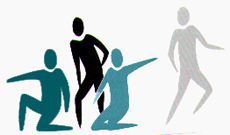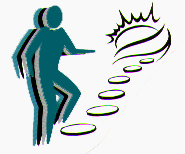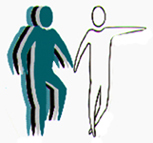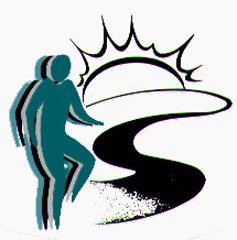
|
The following is the text of a booklet
American Holistic Health Association
The American Holistic Health Association
Edited and Designed by:
Illustrated by:
|
|
If you could choose to enjoy better health, would you be interested? Do increased energy, greater enthusiasm, and an enhanced sense of well-being appeal to you? How about a greater sense of joy? The good news is, these things are possible for you. Within yourself, you have the power you need to create wellness in your life. That power is your power of choice.
Health is more than the absence of disease
Your health is your responsibility
Your power lies in the choices you make every day on your own behalf. If you react out of habit or
fixed attitudes, you may not be using your choices wisely to create wellness in your life. To create
wellness you must expand your focus beyond mere physical health, and:
The captain of the team
Your behavior and the choices you make in your life affect your health. You can choose to do more of what's good for you and the world around you, and to do less of what is harmful. You can choose to learn more about your health and the variety of healthcare options available and you can choose how you will react in a given situation. In order to make wise choices, however, you must know what changes you may need to make. To help you determine your current degree of wellness, take the following short quiz. Do not judge yourself by your answers. Simply accept yourself as you are at this moment, knowing that tomorrow is a new day and that you can always make new choices that will take you closer to the wellness you desire.
Know your team
Caring for the team
For example, working on a challenging project can be exciting and stimulating. Sometimes, however, we will work past the point of exhaustion, neglecting our physical body's need for food and rest, neglecting our emotional need for connection to others, and neglecting our spiritual need for quiet time. This sort of imbalance can lead to illness or disease (dis-ease) in one form or another. Some of us may find ourselves crying easily for no apparent reason. Others may catch a cold or develop stomach problems. Still others may find themselves bingeing on junk food or yelling at their mate.
Training your team
PHYSICAL:
Be a participant--not a spectator
An important difference is in how they react to what happens to them. We always have a choice. In the game of life, the active participant comes out a winner, while the passive spectator is often the loser. When we allow and accept everything that happens to us as though we have no choice, we are taking a passive role in our lives. The feeling that we are victims of circumstances, that we have no choice but to accept our lot in life, leaves us feeling helpless, hopeless and depressed. These negative emotions can cause our physical self to fall down on its job of taking care of itself and fighting off disease.
Motivating your team
We usually change our behavior or attitudes for one of two reasons:
While fear is a useful motivator when we are in immediate danger, it is not a good motivator for long-term change. People who change their habits out of fear often find themselves backsliding and returning to their old ways. Even people who have survived a life-threatening illness may find it difficult to maintain the kind of lifestyle necessary to promote continued health. When we change because we genuinely want to experience the positive results of change, we are much more likely to succeed. Anyone who smokes cigarettes knows how difficult it is to break the habit, but every year thousands of expectant mothers do it out of love for their unborn child.
Don't leave anything out, no matter how silly it may seem. Remember not to use fear as an inducement. In other words, do not list "reduce risk of cancer" as a reason to quit smoking, even though it may be true. Don't get stuck by labeling your choices as either right or wrong. Just choose what is appropriate for you. On the next pages are some wellness practices you might consider. Put a check mark next to those you want to include.
|
|
Look for the positive in every situation.
Benefits:_________________________________________
________________________________________________ Be aware of my thoughts and feelings. Benefits:_________________________________________
________________________________________________ Eat a healthy diet. Benefits:_________________________________________
________________________________________________ Value myself and my creativity. Benefits:_________________________________________
________________________________________________ Exercise regularly.
Benefits:_________________________________________
________________________________________________ Avoid alcohol, tobacco, and other drugs. Benefits:_________________________________________
________________________________________________ Stay open to new ideas. Benefits:_________________________________________
________________________________________________ |
Get adequate rest.
Benefits:_________________________________________
________________________________________________ Accept change willingly. Benefits:_________________________________________
________________________________________________ Express emotions appropriately. Benefits:_________________________________________
________________________________________________ Make decisions based on what I think is best. Benefits:_________________________________________
________________________________________________ Respect myself and others. Benefits:_________________________________________
________________________________________________ List any additional goals and benefits here: _______________________________________________ _______________________________________________ _______________________________________________ _______________________________________________ _______________________________________________ |
|
Taking the first step
The most important step is the first one. Ask yourself which change will benefit you the most. Are you willing to make this change? If so, get started on your path to wellness by making this your first step.
There are a number of ways to go about changing your habits and lifestyle.
As you begin to make the changes needed to achieve and enjoy your wellness, keep these important points in mind:
Calling on the reinforcements
EDUCATIONAL MATERIALS
LOCAL RESOURCES
ORGANIZATIONS
AHHA's resource lists include referrals to various types of healthcare practitioners, research services for conventional and alternative treatment of specific diseases, and catalogs of self-help publications.
HEALTHCARE PRACTITIONERS
The patient/ practitioner partnership
|
|

Understand the situation and ask for options:
Take action:
|

Explain options for addressing the situation:
|
|
It's your choice
Are you ready to take your first step?
You are invited to sign and date this special commitment.
|
|
As you continue on your path to creating wellness, there are many other options waiting to help you. The American Holistic Health Association (AHHA) is available to assist you in finding them. AHHA serves as a national clearinghouse for self-help resources promoting health and well-being. This nonprofit organization has no affiliation with any product, service, or method of healthcare delivery. You are invited to explore the other free materials in the AHHA web site. Each is designed to assist you in further expanding your involvement in enhancing your own health and well-being.
The American Holistic Health Association wishes to thank all those who helped to make this booklet a reality. First, we want to acknowledge two people, without whom this booklet would not have been possible. Suzan Walter conceptualized this project and mentored its progress from beginning to end. She compiled, organized and synthesized the materials, and coordinated the input of the many contributors. Her dedication and care ensured that the perils of group effort did not create a camel instead of a horse, and that the original vision became a reality. Allen Barnes, MD, not only supplied extensive technical guidance to this project, he contributed some of his own pre-published materials. His wise counsel guaranteed that the information remained accurate and appropriate as it was translated from scientific jargon to everyday language. Many other individuals made significant contributions by supplying valuable technical data and important editing suggestions. We appreciate the benefit of their experience, expertise, and perspectives. They include Barbara Ardinger, PhD; Jane Battenberg; Prudence A. Broadwell, ND, LAc; Joan Deniken; Randy Franz; Dahlia Geldin; James S. Gordon, MD; Janice Kelley; Sarah T. Kerr, PhD; Michael J. Kudlas, DC, MEd; Mark Mayell; Patricia A. Monahan; Michael A. Morton, PhD; Susan J. Negus, HHD; Donna A. Peters, PhD, RN; Janet F. Quinn, PhD, RN; Barbara J. Rapp; Chas Ridley; Margaret S. Texidor, PhD, LPC; Molly B. Vass, EdD; Brian Walter; Richard G. Wilcox. Our sincere thanks to all of these individuals and all other past and current members of the AHHA Board of Directors and Board of Advisors.
|







